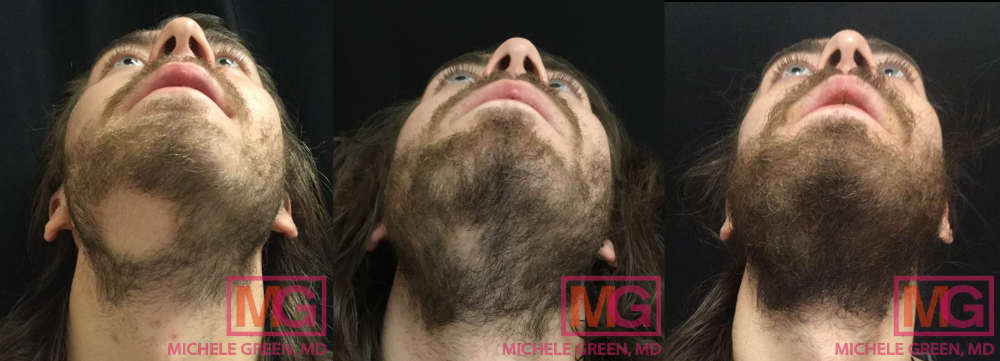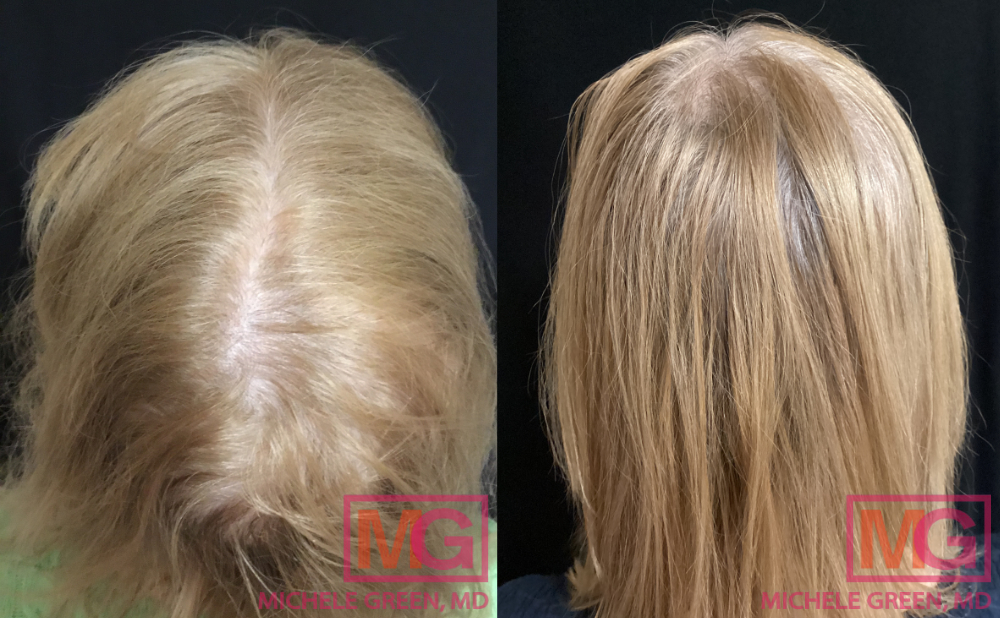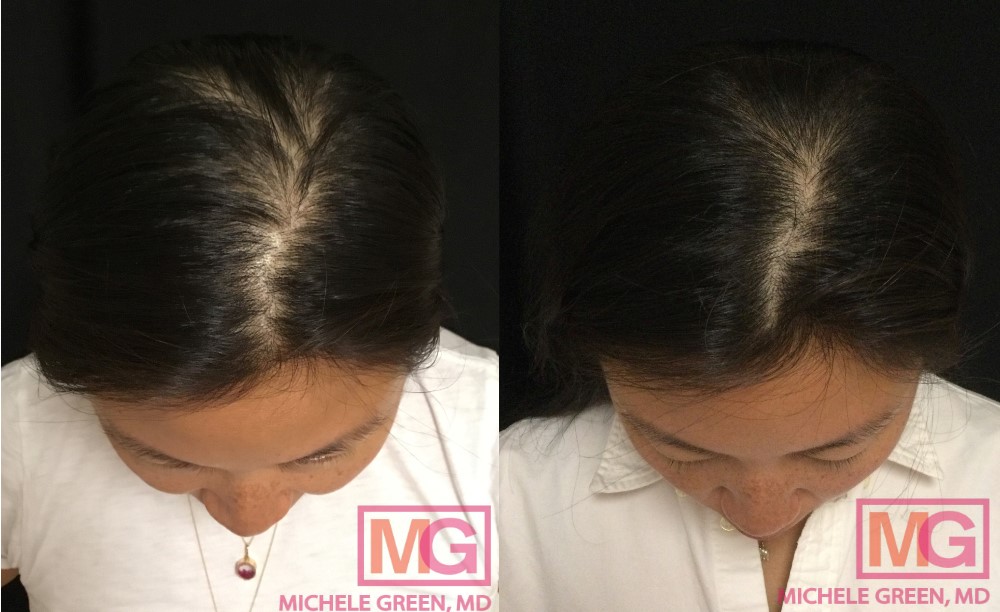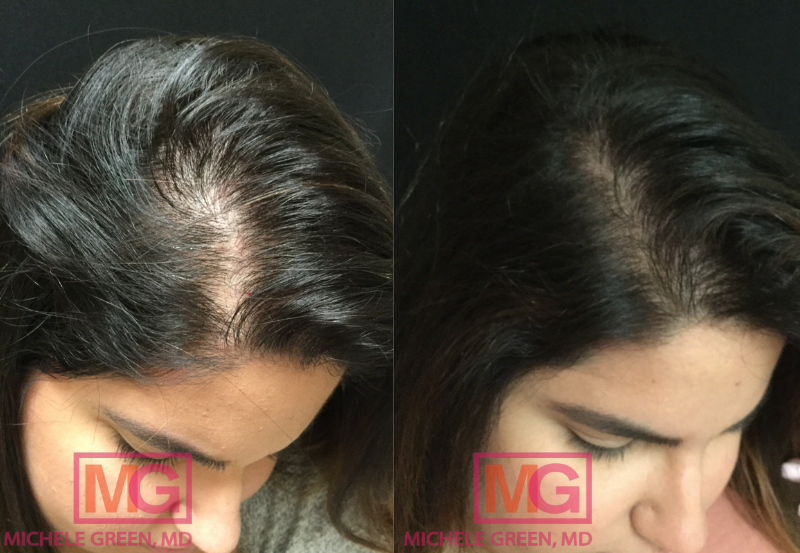Hormones and Female Hair Loss
Hair loss and hair thinning are common conditions that affect as many as 50% of all people assigned female at birth (AFAB). While it is typical to lose between 60 and 100 individual hairs a day, hair loss conditions in AFAB people occur when more than 125 hairs are lost in one day. Depending on the specific type of hair loss that patients experience, hair loss can manifest as thinning at the crown of the head, uneven hair loss in patches on the scalp, or dry or brittle strands of hair that break easily. Some common causes of female hair loss include conditions like androgenic alopecia (female pattern baldness), alopecia areata, telogen effluvium, thyroid hormone problems, rapid weight loss, vitamin deficiency, traction alopecia (caused by tight hairstyles), or certain medications. Many types of hair loss can be helped or reversed with prescription medications, in-office treatments, or lifestyle changes that address the underlying condition. However, it is essential to properly diagnose the cause of hair loss in order to receive the treatment option that will be most effective for you. To figure out what type of hair loss you are experiencing and receive the best possible treatment, schedule your initial consultation with expert board-certified dermatologist Dr. Michele Green.
One of the most common causes of hair loss is hormonal hair loss, which occurs when changing hormone levels in the body affect the hair growth cycle. Hormonal hair loss can be triggered by natural phases of life, such as pregnancy and menopause, or due to genetic conditions like female pattern hair loss (FPHL) or thyroid problems. Hormonal hair loss usually occurs due to increased levels of androgens—also known as “male hormones,”—testosterone and dihydrotestosterone, and decreased levels of “female hormones,” progesterone and estrogen. Treatment for hormonal hair loss can include oral medications that disrupt the production of androgens, such as Finasteride and Spironolactone, or topical medications like Minoxidil (Rogaine), or in-office treatments to increase healthy hair throughout the hair growth cycle, such as Platelet-rich plasma (PRP) injections, microneedling, Laser Cap, Keravive HydraFacials, or hair transplant surgery. When you have your consultation appointment with Dr. Michele Green, she will examine the treatment area to determine the best treatment, or series of treatments, to meet your needs.
Experienced board-certified dermatologist Dr. Michele Green has been expertly treating patients at her Upper East Side New York City dermatology office for more than 25 years. Well-versed in addressing a wide range of cosmetic concerns and medical conditions, Dr. Green is a master at identifying the root cause of hair loss to create an individualized treatment plan that will slow hair shedding and strengthen hair follicles for thicker hair regrowth. In addition to hair loss treatment, Dr. Green is an expert in cosmetic treatments such as Botox, dermal fillers, laser therapy, microneedling, chemical peels, platelet-rich plasma injections, and more. Well-known for high patient satisfaction, Dr. Green has been voted one of the best dermatologists in New York City by such publications as Castle Connolly, Super Doctors, and New York Magazine.
What causes female hair loss?
The most important step in beginning hair loss treatment is receiving an accurate diagnosis of the root cause of the hair loss. Hair shedding and thinning can occur due to genetic predisposition, stress, auto-immune system disorders, thyroid problems, cancer treatment, hormonal changes, or as a side effect of some medications. Below are some of the most common conditions that lead to bald spots, hair loss, or rapid hair shedding:
Androgenetic Alopecia
Androgenetic alopecia, also known as female or male pattern baldness or androgenic alopecia, is a hair loss condition associated with elevated levels of the androgen hormones, which bind to the hair follicles and damage them. While androgenetic alopecia is most commonly associated with men, people assigned female at birth also experience the condition at high rates—especially after menopause. In men, male pattern hair loss typically begins with hair thinning at the temples, resulting in a receding hairline that creates the characteristic “M” shape. Hair loss continues on the crown of the head and can continue to worsen over time. In women (female pattern hair loss), thinning hair typically begins along the top of the head, causing the part of the hair to widen. The condition can begin affecting both men and women in their 20s and 30s and can become more prominent with age. The risk factors for developing androgenetic alopecia are yet unknown, though researchers believe that there is a strong genetic component.

Alopecia Areata
Alopecia areata is an autoimmune condition that occurs when white blood cells damage the hair follicle, causing new hair growth to slow and the follicle to shrink. Characterized by bald patches that appear most commonly on the head (though the condition can develop anywhere on the body), alopecia areata can occur suddenly — though it is not associated with stress-related situations. Researchers believe that the condition is genetic, and while some patients can experience alopecia areata followed by full hair regrowth, for some, hair loss may be permanent. For the most part, patients with alopecia areata experience small patches of hair loss the size of a quarter. However, for others, the extent of hair loss may be more extreme. Alopecia areata can affect patients of any age and gender and frequently comes on quickly — within the span of a few days.
Telogen Effluvium
Telogen effluvium is a hair loss condition caused by extreme stress or shock, which triggers hair to enter the resting phase of hair growth (known as the telogen phase) prematurely. As a result, a large number of hairs enter the shedding phase at the same time — sometimes, as many as 70% of the hairs on the scalp can be shed at once, leading to noticeable hair thinning and shedding. Stressful events that can trigger telogen effluvium include:
- Severe illness, such as chronic illness or high fever
- Childbirth
- Overactive thyroid
- Severe infections
- Severe psychological distress
- Major surgery or injury
- Losing weight quickly, such as crash diets or anorexia
- Some medications
Typically, hair regrows in three to six months once the stressful event has been resolved, but seeking treatment from a dermatologist can help speed up the regrowth process and ensure the overall health of the hair follicles.
What is hormonal hair loss?
Hormonal hair loss is any hair loss or hair thinning that occurs due to changing hormone levels in the body. When levels of androgens, such as testosterone and dihydrotestosterone, increase and levels of progesterone and estrogen decrease, hair loss and hair thinning are more likely to occur. The condition of androgenic alopecia—also known as female pattern hair loss (FPHL) or female pattern baldness—increases the activity of androgens, which can bind to hair follicles, disrupting the hair growth cycle by shortening the growth phase and causing the hair follicles to shrink. Hormonal hair loss can also arise due to thyroid problems (hypothyroidism or hyperthyroidism), high levels of stress, or polycystic ovary syndrome (PCOS).
What is the hair growth cycle?
The hair growth cycle occurs in three phases: the anagen phase (hair growth phase), the catagen phase (transition phase), and the telogen phase (resting phase). During the anagen phase, the hair will grow from follicles on your scalp. At any one time, the vast majority of the hair on your head is in the anagen phase—usually 85-90%—and this phase can last anywhere between two and eight years. Next, the hair will enter the catagen phase—also known as the transition phase—where the hair follicle shrinks, causing the hair shaft to move up to the skin’s surface and separate from the follicle. The catagen phase typically takes two to three weeks to complete. Finally, the hair enters the resting phase—or the telogen phase—where it stays for two to four months before falling out. It is a normal part of the hair growth process for hair to fall out, and typically, 50 to 100 individual hairs are shed every day. Hair loss conditions occur when more than 125 individual hairs are lost on a daily basis, which can lead to hair thinning and balding.

Do menopause and estrogen levels affect hair growth and hair loss?
During menopause, the body undergoes many changes, including hormone fluctuations, which can affect hair growth and eventually lead to hair loss, hair thinning, and even hair growth in areas that did not have growth before. When the female body enters menopause, the levels of hormones like estrogen and progesterone decrease while levels of androgens like testosterone and dihydrotestosterone increase. Increased levels of androgen hormones can disrupt the hair growth cycle, causing the anagen phase to be shortened and increasing the amount of time between the telogen phase and the new growth phase. Dihydrotestosterone can also damage hair follicles, leading to thinner, more brittle hair.
What does low estrogen hair loss look like?
Hormonal fluctuations can lead to female-pattern hair loss (FPHL) when estrogen levels decrease and androgen levels increase. After menopause, hair thinning is extremely common for women, with as many as two-thirds of all women experiencing hair thinning or bald spots. Most patients are familiar with male-pattern hair loss, which manifests as thinning at the temples—forming the characteristic “M” hairline—and at the crown of the head. Female-pattern hair loss differs in that it typically manifests as a widening of the part along the top of the head.
Is female hormonal hair loss reversible?
Patients often wonder, “Can hormonal hair loss grow back?” Female hormonal hair loss is a common condition affecting as many as 30 million people in the United States. Hair loss can be distressing for many, as a person’s hair can often form a large part of their identity. Many women find that hair thinning can seriously affect their self-esteem. Depending on the underlying cause, hair loss may or may not be reversible. When hair loss occurs following pregnancy, most patients find that their hair regrows completely when the hair growth cycle resets following the birth of their child. When hair loss is caused by a medication or underlying medical condition, full hair regrowth is often possible when the medication is stopped and the condition is addressed. For hormonal hair loss conditions like androgenic alopecia, full hair regrowth may not be possible, as damage to the hair follicle has often occurred. However, expert board-certified dermatologist Dr. Green has many treatment options that can slow the rate of hair thinning and strengthen the hair follicles.
How do you treat hormonal hair loss in women? What is the best hair loss treatment?
At Dr. Green’s Upper East Side New York City dermatology office, many treatment options are available for hormonal hair loss. The best way to find out which treatment, or series of treatments, will work best for you is to consult with an expert dermatologist like Dr. Green. No one treatment option is better than the rest. Rather, the best treatment option for you depends on the type of hormonal hair loss occurring and the size and scope of the treatment area. Patients experiencing high levels of androgen hormones may benefit most from prescription medications that can decrease androgen levels, such as Finasteride and Spironolactone. To promote healthier hair growth, Dr. Green may recommend in-office treatments like microneedling, PRP injections, LaserCap treatment sessions, HydraFacials, or topical treatments like Minoxidil. If vitamin deficiency is a potential cause of hair loss, vitamin or iron supplements can improve hair regrowth.

How do I stop my hair from thinning as a female?
Hormonal hair loss conditions like androgenetic alopecia are genetic, meaning little can be done to prevent hair thinning completely. However, lifestyle changes can reduce the risk of hair thinning and promote healthy hair growth. Hair follicles can be weakened or damaged by tight hairstyles that constantly pull on the hair or frequent use of hats, scarves, and wigs. Wearing the hair in loose styles will reduce the risk of traction alopecia and decrease potential damage to hair follicles. Additionally, chemical hair treatments, like hair relaxers or hair dye, can damage the hair follicles. Avoiding these types of hair treatments will help to reduce the risk of follicle damage. Maintaining a healthy diet can also help to promote hair health by eating foods rich in iron and taking vitamins and supplements.
What is prescribed for hormonal hair loss?
Female patients experiencing hormonal hair loss may be prescribed one of the following medications:
Spironolactone is an anti-androgen medication and the most commonly prescribed oral treatment for women. It plays a role in hormone regulation and is particularly useful for female patients with Polycystic Ovary Syndrome (PCOS)- related hair loss. It has been FDA-approved and works as a hair loss treatment by slowing down the production of male androgen hormones. A board-certified dermatologist must monitor treatment with spironolactone so that adjustments can be made as necessary. Some of the potential side effects include depression, fatigue, weight gain, and sexual dysfunction.
Oral minoxidil was originally prescribed for regulating high blood pressure when it was discovered that one of the side effects was new hair growth. Since then, it has been found that a low dose of oral minoxidil is a safe and effective hair-loss treatment. Oral minoxidil strengthens the hair follicles, promoting greater hair retention and regrowth. In clinical trials, nearly 80% of patients reported their hair became thicker and longer while taking oral minoxidil. For many patients, the oral version of minoxidil is a convenient alternative to the topical since it does not leave any residue on the scalp, is easier than applying a solution twice daily, and can safely be used in conjunction with other hair loss treatment options.
Finasteride, commonly known as Propecia, has been FDA-approved as a hair loss treatment and works by blocking the conversion of testosterone into dihydrotestosterone in the body, resulting in lower levels of DHT. DHT is an androgen hormone that can bind to hair follicles, preventing new hair growth. Propecia effectively treats both men and post-menopausal women with hair loss and thinning hair. Women who are currently pregnant or planning to become pregnant should not handle finasteride, as the medication may cause birth defects.
Dutasteride, like finasteride, treats hair thinning and hair loss by inhibiting the conversion of testosterone to dihydrotestosterone (DHT). DHT is an androgen hormone that plays a role in developing male sex characteristics such as facial and body hair. DHT can also bind to androgen receptors in the scalp, which causes the hair follicles to cease the production of new hair. Although dutasteride has yet to be approved by the FDA, recent clinical studies demonstrate the benefits of the medication as a hair loss treatment. A board-certified dermatologist, such as Dr. Michele Green in NYC, may prescribe oral dutasteride for “off-label” use if it is determined to be medically appropriate for a patient.
Oral contraceptives can help to regulate hormones in the body that may be contributing to thinning hair and hair loss. Some forms of birth control may cause hair loss in some women, whereas others with androgenetic alopecia may benefit from taking certain forms of birth control pills as a hair loss treatment. Due to the varied effects, it is important to consult with an expert regarding oral contraceptives for treating hair loss. In general, for an oral contraceptive to be an effective hair loss treatment, it must have a low androgen index. Low-androgen birth control can help regulate hormones and promote an extended anagen phase of hair growth, resulting in more new hair and an overall reduction in hair loss and hair thinning.
Can women use five percent minoxidil?
Yes. Minoxidil (Rogaine) is a safe and effective topical treatment option that is FDA-approved for reducing hair thinning and stimulating hair growth. Women can safely use a 5% minoxidil solution to address hormonal hair loss conditions like androgenic alopecia. Minoxidil should not be prescribed for patients who are pregnant, wish to become pregnant, or are breastfeeding. Some minor side effects are associated with the topical treatment, including scalp irritation, dryness, scaling, itching, and redness. Patients who find minoxidil effective will need to continue using the medication to maintain the treatment results. Stopping the application will result in continued hair loss.
How can I treat hormonal hair loss at home?
For the most effective treatment results, it is best to consult with an expert board-certified dermatologist, such as Dr. Michele Green, who can recommend in-office treatments or prescription medications to promote new hair growth. Some lifestyle changes or at-home treatment solutions can help to strengthen hair follicles and support new hair growth. Maintaining a healthy diet can improve hair growth with foods like red meat, chickpeas, fish, eggs, and beans that are rich in iron, zinc, and Vitamin D. Taking supplements that contain biotin has also been shown to improve overall hair health. Stress can be a major factor in increasing hair loss, so limiting daily stressors can help to prevent hair thinning and hair loss.
How do I know if my hair loss is hormonal?
One of the contributing factors to female hair loss is hormonal imbalances. Cortisol, thyroid, and testosterone are the most common hormones that influence hair loss patterns in women. Cortisol is a hormone that is released during both short-term and long-term mental, physical, or emotional stress. High levels of cortisol can interfere with the normal activity of the hair follicles, causing hair loss. Thyroid conditions, including both hypothyroidism and hyperthyroidism, can also negatively affect hair regrowth patterns by disrupting normal cycles. Elevated levels of testosterone in women can also contribute to hair loss. Testosterone is an androgen hormone that converts to DHT, which binds to the hair follicles and prevents healthy hair growth.
Although testosterone is a male androgen hormone, it is present in both sexes, and an imbalance in testosterone in men and women could lead to hair loss. To determine whether a hormonal imbalance contributes to your female hair loss, it is essential to consult with an expert in hair loss, such as board-certified dermatologist Dr. Michele Green. When you meet with Dr. Green at her private dermatology office in the Upper East Side neighborhood of Manhattan, she will physically assess the condition of your scalp and hair, as well as order certain blood tests to identify any potential imbalances. The results of the blood tests may influence the recommended hair loss treatment options that are integrated into your treatment plan.

Which vitamin deficiency causes hair loss?
Vitamins are very important in the hair growth cycle, providing the nutrients necessary for healthy hair follicles and hair growth. Studies have demonstrated that deficiencies in vitamins D and B12 are often found in patients with androgenic alopecia, suggesting that low levels of these vitamins may contribute to the appearance of this condition. As such, certain vitamin supplements, such as biotin, Vitamin C, and Vitamin B, have been clinically shown to improve the appearance of thinning hair by promoting hair growth. Two of the most popular vitamin supplements are Viviscal and Nutrafol. Viviscal contains the active ingredients biotin and vitamins C and B to encourage new hair growth. Nutrafol helps treat hormone imbalances, reduce stress, and improve nutrient levels, treating the underlying causes of hair loss.
What does thyroid hair loss look like?
Thyroid conditions can contribute to hair loss and affect the hair growth cycle, resulting in sudden and widespread shedding of hair. Hair that remains on the head is often dry, brittle, and breaks easily. Other symptoms that can arise due to a thyroid condition can include persistent fatigue, weight gain, constipation, dry skin, and muscle weakness. When you have your initial consultation with Dr. Green, she will perform a blood test if she suspects that your thyroid hormone levels are off. If a thyroid condition is responsible for hair loss, medication will be prescribed to regulate thyroid hormone levels.
What doctor should I see for hormonal hair loss?
Dermatologists are highly experienced in treating hair loss conditions. In addition to treating skin conditions such as acne breakouts, acne scars, hyperpigmentation, fine lines, wrinkles, facial volume loss, and uneven skin texture, dermatologists are highly skilled in diagnosing hair loss conditions and prescribing the medication or treatment options that will best combat symptoms of hair shedding. Dr. Green, in particular, is well-known for the care she takes when diagnosing patients and developing individualized treatment plans to promote hair regrowth, thicken and strengthen the hair follicle, and prevent or slow future hair shedding.
How to fix hormonal imbalance after hair loss
Hormonal imbalance may be an underlying cause for some hair loss conditions, including androgenetic alopecia, thyroid hormonal imbalance, and high cortisol levels due to persistent stress. If patients are experiencing hair loss due to a thyroid condition, Dr. Green will recommend medication to help balance thyroid hormone levels, which can help to fix the imbalance and reduce the risk of continued hair loss. Female patients experience dropping levels of progesterone and estrogen and rising levels of androgens after menopause, which can contribute to hair thinning and hair loss. In that case, Dr. Green may prescribe an anti-androgen medication to help balance the hormones and prevent additional damage to the hair follicles. To find out which treatment option works best for you, you can schedule your first appointment with Dr. Michele Green.
How to get started with hair loss treatment today
Hair loss can be a devastating condition, and this is particularly true for women. For many women with hair loss and hair thinning, their condition may induce feelings of self-consciousness or low self-esteem. There are many potential contributing factors when it comes to hair loss and hair thinning, including genetics, hormonal imbalances, stress, diet, hair styling practices, underlying health conditions, certain medications, and more. A hair loss specialist, like Dr. Michele Green in NYC, can help determine the underlying causes of hair loss and recommend the best hair loss treatments for preventing additional loss and promoting new hair growth. In any case, the best approach for preventing and treating thinning hair or hair loss is always to have an early evaluation by a board-certified dermatologist like Dr. Green in NYC.
Dr. Michele Green is an internationally renowned board-certified dermatologist with over two and a half decades of experience providing her patients with the best non-invasive treatment options. Dr. Green takes a holistic approach and embraces a less-is-more philosophy, creating customized skincare routines and treatment plans that cater to the unique concerns and aesthetic goals of her patients. She is consistently identified as one of New York’s best dermatologists by Castle Connolly, New York Magazine, and Super Doctors for her dedication to her patients and expertise. Please call us at 212-535-3088 or email our New York City-based office today to schedule a consultation with Dr. Michele Green, who will determine the best treatment option for hormonal hair loss.
 212-535-3088
212-535-3088